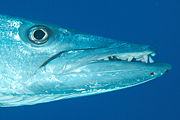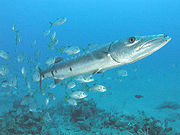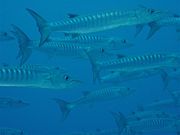Barracuda
2008/9 Schools Wikipedia Selection. Related subjects: Insects, Reptiles and Fish
| Barracuda Fossil range: Early Eocene to Present |
||||||||||||
|---|---|---|---|---|---|---|---|---|---|---|---|---|
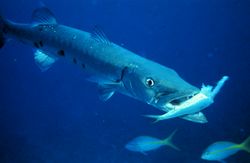 Great barracuda, Sphyraena barracuda, with prey
|
||||||||||||
| Scientific classification | ||||||||||||
|
||||||||||||
| Species | ||||||||||||
|
See text. |
The barracuda is a ray-finned fish known for its large size (up to 6 ft in length and up to a foot in width, for some species ) and fearsome appearance. Its body is long, fairly compressed, and covered with small, smooth scales. It is found in tropical and subtropical oceans worldwide. It is of the genus Sphyraena, the only genus in the family Sphyraenidae.
Appearance and physical description
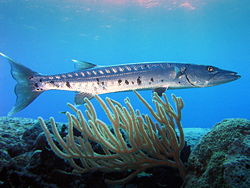
Barracudas are elongated fish with powerful jaws. The lower jaw of the large mouth juts out beyond the upper. Barracudas possess strong, fang-like teeth. These are unequal in size and set in sockets in the jaws on the roof of the mouth. The head is quite large, pointed, and it is pike-like in appearance. The gill-covers do not have spines and are covered with small scales. The two dorsal fins are widely separated, with the first having five spines and the second having one spine and nine soft rays. The second dorsal fin equals the anal fin in size and is situated more or less above it. The lateral line is prominent and extends straight from head to tail. The spinous dorsal fin is placed above the pelvics. The hind end of the caudal fin is forked or concave. It is set at the end of a stout peduncle. The pectoral fins are placed low down on the sides. The barracuda swim bladder is large.
In general, the barracuda's coloration is dark green or gray above chalky-white below. This varies somewhat. Sometimes there is a row of darker cross-bars or black spots on each side. The fins may be yellowish or dusky. Barracudas only live in oceans.
Only some species of barracuda grow to a large size. The species which do are the European barracuda, barracouta or spet (S. sphyraena), found in the Mediterranean and eastern Atlantic; the great barracuda, picuda or becuna (S. picuda), ranging on the Atlantic coast of tropical America from Florida to Brazil and reaching the Bermudas; the California Barracuda (S. argentea), extending from Puget Sound southwards to Cabo San Lucas; the Indian barracuda (S. jello) and the black-finned or Commerson's barracuda (S. commersoni), both from the seas of India and the Malay Peninsula and Archipelago.
Behaviour
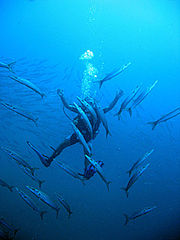
Barracudas occur both singly and in schools around reefs, but also appear in open seas. They are voracious predators and hunt using a classic example of lie-in-wait or ambush. They rely on surprise and short bursts of speed (up to 27mph (43 km/h)) to overrun their prey, sacrificing maneuverability.
The larger barracudas are more or less solitary in their habits. Young and half-grown fish frequently congregate in schools. Their food is composed of fish of all types. Large barracudas, when gorged, may attempt to herd a shoal of prey fish in shallow water, where they guard over them until they are ready for another meal.
Barracudas and humans
Like sharks, barracudas have long had a bad reputation as being dangerous to humans, even though hundreds of scuba divers have lost a finger or two to a large, angry barracuda that's protecting its territory from large, unfamiliar creatures like man. Barracudas have been observed following snorkelers and scuba divers across a reef, which can make one feel uncomfortable, but they are harmless unless provoked. As barracudas are also scavengers, they may mistake snorkelers for large predators and follow them to scavenge the remains of any prey left after an attack.
Being formidable hunters, they should be respected, as barracudas are perfectly capable of defending themselves against humans that harass them. Handfeeding or trying to touch them is strongly discouraged. Spearfishing around barracudas can also be quite dangerous, as they are strongly attracted by the wounded fish.
There have been isolated cases where barracudas have bitten a human, but these incidents are rare and are believed to be caused by bad visibility. Barracudas will stop after the first bite as humans are not their normal food source.
Wearing jewelry and other shiny objects is discouraged as barracudas are quite attracted to things that glint and shine.
As food
Barracudas are caught as both food and game fish. They are most often eaten as fillet or steak and have a strong taste like tuna or salmon. Larger species, like the great barracuda, have in some areas been implicated in cases of ciguatera food poisoning. In southern Nigeria, West Africa they are smoked and used in the preparation of different soups. The reason for smoking is because when cooked fresh, the fish is quite soft and disintegrates in the soup.
Angling
Barracuda are prize fish, and can be caught either by fly or sea fishing. They are extremely powerful, and require tough and strong rods.
Species
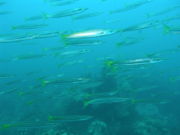
There are 26 known species:
- Sharpfin barracuda, Sphyraena acutipinnis Day, 1876.
- Guinean barracuda, Sphyraena afra Peters, 1844.
- Pacific barracuda, Sphyraena argentea Girard, 1854.
- Great barracuda, Sphyraena barracuda (Edwards in Catesby, 1771).
- Northern sennet, Sphyraena borealis DeKay, 1842.
- Yellowstripe barracuda, Sphyraena chrysotaenia Klunzinger, 1884.
- Mexican barracuda, Sphyraena ensis Jordan & Gilbert, 1882.
- Yellowtail barracuda, Sphyraena flavicauda Rüppell, 1838.
- Bigeye barracuda, Sphyraena forsteri Cuvier, 1829.
- Guachanche barracuda, Sphyraena guachancho Cuvier, 1829.
- Heller's barracuda, Sphyraena helleri Jenkins, 1901.
- Sphyraena iburiensis Doiuchi & Nakabo, 2005.
- Pelican barracuda, Sphyraena idiastes Heller & Snodgrass, 1903.
- Japanese barracuda, Sphyraena japonica Cuvier, 1829.
- Pickhandle barracuda, Sphyraena jello Cuvier, 1829.
- Lucas barracuda, Sphyraena lucasana Gill, 1863.
- Australian barracuda, Sphyraena novaehollandiae Günther, 1860.
- Obtuse barracuda, Sphyraena obtusata Cuvier, 1829.
- Southern sennet, Sphyraena picudilla Poey, 1860.
- Red barracuda, Sphyraena pinguis Günther, 1874.
- Sawtooth barracuda, Sphyraena putnamae Jordan & Seale, 1905.
- Blackfin barracuda, Sphyraena qenie Klunzinger, 1870.
- European barracuda, Sphyraena sphyraena (Linnaeus, 1758).
- Sphyraena tome Fowler, 1903.
- Yellowmouth barracuda, Sphyraena viridensis Cuvier, 1829.
- Sphyraena waitii Ogilby, 1908.
